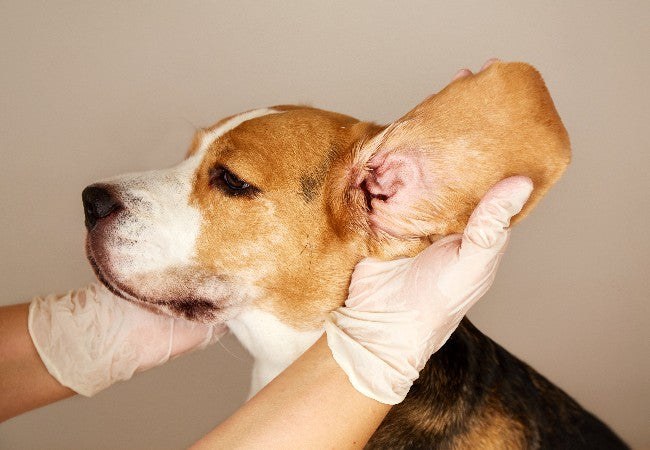Signs Your Dog Has an Ear Infection 2025 Vet Guide to Spot & Treat 🐾

In this article
Signs Your Dog Has an Ear Infection 2025 Vet Guide to Spot & Treat 🐾
By Dr. Duncan Houston BVSc
🔍 Why Early Detection Matters
Ear infections—especially otitis externa—are among the most common health issues in dogs. When left untreated, they can progress into deeper ear structures, causing pain, balance issues, and hearing loss.
👂 Top Signs to Watch For
- 🔥 Redness and inflammation of the ear canal or flap.
- 👃 Yeasty or corn chip odor from inside the ear.
- 💧 Discharge: dark brown, yellow, or bloody.
- 🪶 Scratching or pawing at ears.
- 🔄 Head shaking or tilting side to side.
- 😣 Pain or sensitivity when touching the ear.
- 🧠 Balance issues (circling, stumbling) in cases involving the middle/inner ear.
- 🩹 Scabs, crusts, swelling or hematomas on the ear flap.
🎯 Who’s Most at Risk?
While any dog can get infected, certain breeds and conditions increase risk:
- Basset Hounds, Cockers, Labradoodles, Shar-Peis, Beagles: floppy ears trap moisture; narrow ear canals hinder ventilation.
- Frequent swimmers: moisture in ears sets the stage for infection.
- Allergies or skin disorders: trigger yeast or bacterial overgrowth.
🧪 What Causes Ear Infections?
- Bacteria (e.g., Staphylococcus, Pseudomonas)
- Yeast—common, especially Malassezia.
- Ear mites, foreign bodies (grass awns), and excessive moisture.
- Underlying conditions: allergies, hypothyroidism, chronic inflammation.
🩺 Diagnosing Ear Infections
Your vet may:
- 🔬 Perform an otoscopic exam of ear canal and eardrum.
- 🧫 Take cytology (swab) to identify yeast or bacteria.
- 🧪 Conduct culture/sensitivity if infection is chronic or resistant.
- 🧭 Use imaging if infection has spread to middle/inner ear.
🛠️ Treatment Strategies
- 🧼 Clean ears thoroughly before medication—flushing helps drug contact.
- 💊 Use topical antimicrobials (antibiotic ± antifungal ± steroid).
- 🧩 Consider oral meds for severe or deep infections.
- 🏥 Surgery (e.g., hematoma drainage) in select cases.
- 🔄 Address underlying issues—goals include allergen control, dryness, ear grooming.
📅 Preventing Recurrence
- 🧽 Clean ears weekly or after swims using vet-approved cleaner.
- ✂️ Trim excess ear hair if breed-prone.
- 🍖 Maintain a healthy diet with balanced fatty acids.
- 🏥 Manage allergies, endocrine issues, and keep regular vet check-ups.
🧸 Ask A Vet,
- 🩺 **Ask A Vet:** On‑demand diagnosis guidance, product advice, follow‑up support.
📋 At‑Home Ear Check Routine
| Step | Action |
|---|---|
| 1 | Inspect ear—lift flap weekly to check for redness, debris, odor. |
| 2 | Clean gently with vet‑approved solution; dry thoroughly. |
| 3 | Monitor for early warning signs (shake, scratch). |
| 4 | If signs persist 48 hrs, consult vet. |
🎯 Final Thoughts
Ear infections often begin subtly, but a few simple checks each week can save your pup a lot of discomfort. If you spot any signs—particularly odor, discharge, or persistent head shaking—schedule a vet check. Treatment tailored to the cause, paired with ongoing care, helps prevent recurrence and keeps your dog's ears healthy and happy 🐶💕.
— Dr Duncan Houston, BVSc
Need expert help taking care of your dog’s ears? Visit AskAVet.com or download the Ask A Vet app for 24/7 vet support.






